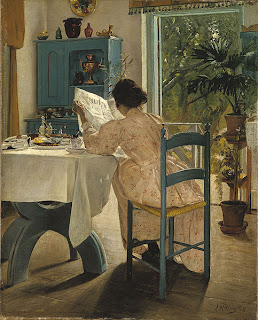Yesterday Loretta showed us how the 18th c English table of an affluent household would be set for dessert. Here's a selection of dishes that could have been served.
Georgian diners would not have recognized the massive, death-by-chocolate style of desserts so dear to modern tastes. To them, the dishes offered at the end of a meal should be simple and light (at least light in comparison to the multiple meat dishes and puddings that might have come before), and were intended to refresh and cleanse the palate. "Rich cakes" were reserved for grand celebrations like weddings and balls, and even those were more like modern pound cakes, depending more on their use of butter and eggs instead of sugary frosting.
Here are several favorite desserts, prepared from 18th c recipes by the cooks of the Governor's Palace, Colonial Williamsburg.
In the fluted glasses are chocolate creams, a close cousin to our chocolate puddings. An 1824 recipe for Chocolate Cream from Mary Randolph's Virginia House-Wife is only two sentences long: "Scrape a quarter of a pound of chocolate very fine, put it in a quart of milk, boil it till the chocolate is dissolved, stirring it continually, & thicken with six eggs. A Vanilla bean boiled with the milk, will improve the flavour greatly." Much more challenging than it sounds, as any cook who has struggled with clumping chocolate and curdling eggs can sadly attest.
The pineapple represents fresh fruit, always a popular offering. It would, obviously, not have been presented at the table like this, but would have been cored, trimmed, and cut into more manageable pieces. Pineapples and oranges were imported, exotic, and expensive, a sign that the host spared no expense for his guests (but not as an apocryphal symbol of hospitality.)
Below the pineapple is a dish of chocolate almond conceits. The conceit is that there are no almonds in the recipe, but simply chocolate (and sugar and butter, much like fudge) shaped like almonds, and dusted with sugar.
Next is a small dish of caraway comfits, especially popular with a decanter of port. Caraway seeds are dipped repeatedly in a sugar syrup to build up crisp layers, and then rolled in sugar.
The last of the desserts is a plate of ratafia cakes. Ratafia cakes (or biscuits) took their name from the fruit-flavored brandies with which they were often eaten, though by the early 19th c they're being consumed with coffee and tea by both Jane Austen's friend Martha Lloyd and Captain Jack Aubrey. Ground almonds, egg whites, and sugar are the essential ingredients, similar to macaroons. If you'd like to try them yourself, here's the 1726 recipe used by the Governor's Palace cooks - plus an adaptation for modern cooks and kitchens.
Many thanks to Frank Clark, Rob Brantley, and Susan Holler of Colonial Williamsburg for sharing their kitchen wisdom.




































 One of us --
One of us -- 


